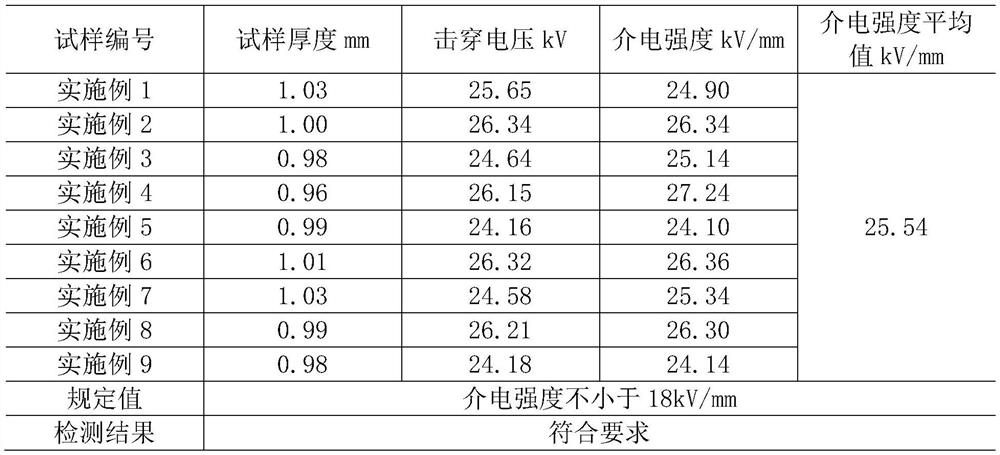A composite insulator for preventing the growth of microorganisms and algae
A composite insulator, composite insulation technology, applied in insulators, biocide-containing paints, antifouling/underwater coatings, etc., can solve the problems of reducing the insulation level of composite insulators, easy oxidation, and reducing insulation performance, and increase the scope of use. and service life, excellent hydrophobicity and bactericidal ability, and the effect of improving the carrying voltage capacity
- Summary
- Abstract
- Description
- Claims
- Application Information
AI Technical Summary
Problems solved by technology
Method used
Image
Examples
Embodiment 1
[0037] In parts by weight, 6 parts of nano-zinc oxide bacteriostatic agent, 7 parts of nano-titanium dioxide bacteriostatic agent, 3 parts of cuprous chloride antifungal agent, 4 parts of cadmium sulfide anti-algae agent, 20 parts of polydimethylsiloxane , 5 parts of fluorosilicone oil, 9 parts of 2-ethylhexyl acrylate, 10 parts of cellulose acetate, 15 parts of EPDM rubber, 10 parts of decabromodiphenyl ether, 10 parts of dipentaerythritol hexaacrylate, sodium melamine phosphate 8 parts, 25 parts of silicon dioxide, 15 parts of aluminum hydroxide micropowder, 5 parts of hydroxyl silicone oil, 3 parts of γ-aminopropyltriethoxysilane, 2,5-dimethyl-2,5-bis(tert-butyl 1 part of hexane, 10 parts of toluene, and 30 parts of petroleum ether.
[0038] The antibacterial and anti-algae composite material is prepared as a thin film and arranged on the surface of the composite insulating umbrella cover substrate in the form of a film, including the following steps:
[0039] A. Mix and r...
Embodiment 2
[0044] In parts by weight, 8 parts of nano-zinc oxide bacteriostatic agent, 9 parts of nano-titanium dioxide bacteriostatic agent, 5 parts of cuprous chloride antifungal agent, 6 parts of cadmium sulfide anti-algae agent, 25 parts of polydimethylsiloxane , 8 parts of fluorosilicone oil, 7 parts of 2-ethylhexyl acrylate, 15 parts of cellulose acetate, 20 parts of EPDM rubber, 13 parts of decabromodiphenyl ether, 5 parts of dipentaerythritol hexaacrylate, sodium melamine phosphate 3 parts, 15 parts of silicon dioxide, 10 parts of aluminum hydroxide micropowder, 3 parts of hydroxyl silicone oil, 4 parts of γ-aminopropyltriethoxysilane, 2,5-dimethyl-2,5-bis(tert-butyl 2 parts of base peroxy) hexane.
[0045] The antibacterial and anti-algae composite material is prepared as a thin film and arranged on the surface of the composite insulating umbrella cover substrate in the form of a film, including the following steps:
[0046] A. Mix and refine the above-mentioned raw materials t...
Embodiment 3
[0051] In parts by weight, 10 parts of nano-zinc oxide bacteriostatic agent, 8 parts of nano-titanium dioxide bacteriostatic agent, 7 parts of cuprous chloride antifungal agent, 8 parts of cadmium sulfide anti-algae agent, 30 parts of polydimethylsiloxane , 10 parts of fluorosilicone oil, 6 parts of 2-ethylhexyl acrylate, 18 parts of cellulose acetate, 30 parts of EPDM rubber, 15 parts of decabromodiphenyl ether, 8 parts of dipentaerythritol hexaacrylate, sodium melamine phosphate 5 parts, 10 parts of silicon dioxide, 20 parts of aluminum hydroxide micropowder, 4 parts of hydroxyl silicone oil, 5 parts of γ-aminopropyltriethoxysilane, 2,5-dimethyl-2,5-bis(tert-butyl 3 parts of hexane, 30 parts of toluene, and 20 parts of petroleum ether.
[0052] The antibacterial and anti-algae composite material is prepared as a thin film and arranged on the surface of the composite insulating umbrella cover substrate in the form of a film, including the following steps:
[0053] A. Mix and...
PUM
 Login to View More
Login to View More Abstract
Description
Claims
Application Information
 Login to View More
Login to View More - R&D
- Intellectual Property
- Life Sciences
- Materials
- Tech Scout
- Unparalleled Data Quality
- Higher Quality Content
- 60% Fewer Hallucinations
Browse by: Latest US Patents, China's latest patents, Technical Efficacy Thesaurus, Application Domain, Technology Topic, Popular Technical Reports.
© 2025 PatSnap. All rights reserved.Legal|Privacy policy|Modern Slavery Act Transparency Statement|Sitemap|About US| Contact US: help@patsnap.com



